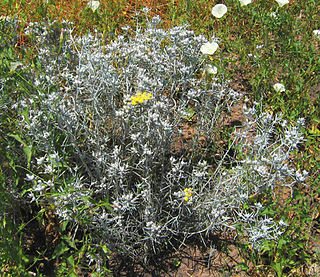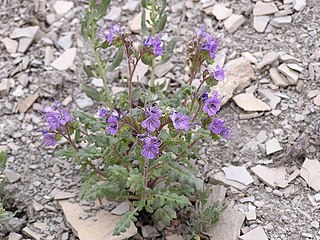
The Green River Formation is an Eocene geologic formation that records the sedimentation in a group of intermountain lakes in three basins along the present-day Green River in Colorado, Wyoming, and Utah. The sediments are deposited in very fine layers, a dark layer during the growing season and a light-hue inorganic layer in the dry season. Each pair of layers is called a varve and represents one year. The sediments of the Green River Formation present a continuous record of six million years. The mean thickness of a varve here is 0.18 mm, with a minimum thickness of 0.014 mm and maximum of 9.8 mm.

The Uinta Basin is a physiographic section of the larger Colorado Plateaus province, which in turn is part of the larger Intermontane Plateaus physiographic division. It is also a geologic structural basin in eastern Utah, east of the Wasatch Mountains and south of the Uinta Mountains. The Uinta Basin is fed by creeks and rivers flowing south from the Uinta Mountains. Many of the principal rivers flow into the Duchesne River which feeds the Green River—a tributary of the Colorado River. The Uinta Mountains forms the northern border of the Uinta Basin. They contain the highest point in Utah, Kings Peak, with a summit 13,528 feet above sea level. The climate of the Uinta Basin is semi-arid, with occasionally severe winter cold.
Enefit American Oil is a Utah based oil shale exploration and development company. It has been involved in the development of oil shale since 2005. Since 2011 it is a subsidiary of Eesti Energia, internationally known as Enefit.

Arabis macdonaldiana is a species of flowering plant in the mustard family known by the common name MacDonald's rockcress. It is native to northern California and Oregon, where it grows on newly exposed, barren serpentine soils in openings in temperate coniferous forest habitat. It is a rare and endangered plant known from several sites in California and approximately two occurrences in Oregon, where it is threatened mainly by mining, particularly of nickel, which is one of several metals plentiful in the serpentine. On September 29, 1978, this was the second plant to be federally listed as an endangered species.

Tetradymia comosa is a species of flowering plant in the aster family, known by the common name hairy horsebrush.

Tetradymia glabrata is a species of flowering plant in the aster family known by the common name littleleaf horsebrush. It is native to the western United States, especially the Great Basin and Mojave Desert. Its habitat includes sagebrush, woodlands, and scrub. It is an erect, bushy shrub growing to a maximum height over one meter, its stems coated unevenly in white woolly fibers with many bare strips. The narrow, pointed leaves are usually no more than a centimeter long and most occur in clusters along the branches. The inflorescence bears up to seven flower heads which are each enveloped in four woolly phyllaries. Each head contains four yellow cream flowers each around a centimeter long. The fruit is a hairy, ribbed achene with a pappus of bristles.
Tetradymia tetrameres is a species of flowering plant in the aster family known by the common name fourpart horsebrush and dune horsebrush. It is native to the Great Basin, where it occurs in western Nevada and just over the border in Mono County, California. It is a plant of dry scrub and sand dunes. It is a bushy, woolly shrub with many erect, spineless branches. It is the largest of the horsebrushes, growing up to two meters in height. The soft, woolly leaves are narrow and threadlike, growing up to 4 centimeters long. Shorter leaves occur in clusters around the primary leaves. The inflorescence bears 4 to 6 flower heads which are each enveloped in four or five woolly phyllaries. Each head contains up to four or five light yellow flowers each around a centimeter long. The fruit is a hairy achene which may be up to a centimeter long, including its pappus of long bristles.

Borodinia serotina is a rare species of flowering plant in the mustard family known by the common name shale barren rockcress. It is native to eastern West Virginia and western Virginia in and around the Shenandoah Valley, where it is known from fewer than 60 populations. It is endemic to the shale barrens, a type of habitat characterized by steep slopes of bare shale, an exposed, rocky habitat type that is subject to very dry and hot conditions. Shale barrens host a number of endemics, such as Allium oxyphilum and Taenidia montana, and this rockcress is among the rarest. It is a federally listed endangered species.

Phacelia argillacea is a rare species of flowering plant in the borage family known by the common names clay phacelia and Atwood's phacelia. It is endemic to Utah in the United States, where it is known only from one canyon in Utah County. It is "one of Utah's most endangered species"; it is "one of the nation's rarest plants" and is federally listed as an endangered species of the United States.

Schoenocrambe barnebyi is a rare species of flowering plant in the mustard family known by the common names Barneby reed-mustard, Syes Butte plainsmustard, and Barneby thelypody. It is endemic to Utah in the United States, where it is known only from Emery and Wayne Counties. It is threatened by habitat degradation and destruction. It is federally listed as an endangered species of the United States.

Glaucocarpum is a monotypic plant genus containing the single species Glaucocarpum suffrutescens, a rare species of flowering plant in the mustard family known by the common names toad-flax cress, shrubby reed-mustard, Uinta Basin waxfruit and waxfruit mustard. It is endemic to Utah in the United States, where it is known only from Duchesne and Uintah Counties. It is threatened by habitat degradation and destruction. It is federally listed as an endangered species of the United States.

Sclerocactus wetlandicus is a rare species of cactus known by the common name Uinta Basin hookless cactus. It is endemic to Utah in the United States, where it is known only from the Uinta Basin. It may also be called the Pariette cactus, but this name is more appropriate for Sclerocactus brevispinus, the species endemic to the Pariette Draw of Duchesne County.

Townsendia aprica is a rare species of flowering plant in the family Asteraceae known by the common name Last Chance Townsend daisy. It is endemic to Utah in the United States, where it is known from three counties. It faces a number of threats and it is a federally listed threatened species of the United States.

Astragalus limnocharis var. montii, synonym Astragalus montii, is a rare variety of flowering plant in the legume family. It is known by the common name Monti's milkvetch. It is endemic to Utah in the United States, where there are only three known populations. Under the synonym A. montii, it is a federally listed threatened species of the United States.

Penstemon pinorum is a rare species of flowering plant in the plantain family known by the common names Pine Valley penstemon and pinyon penstemon. It is endemic to Utah in the United States, where it is known only from an area along the border between Washington and Iron Counties.

Artemisia pygmaea is a North American species of sagebrush in the aster family known by the common name pygmy sagebrush.

Penstemon grahamii, known by the common names Uinta Basin beardtongue and Graham's beardtongue, is a species of flowering plant in the plantain family. It is native to Utah and Colorado in the United States.

Physaria congesta is a rare species of flowering plant in the mustard family known by the common name Dudley Bluffs bladderpod. It is endemic to western Colorado in the United States, where it is known only from seven occurrences in Rio Blanco County. It is federally listed as a threatened species.

Physaria tumulosa is a rare species of flowering plant in the family Brassicaceae known by the common name Kodachrome bladderpod. It is endemic to Utah in the United States, where it is known only from Kane County. There is only one known population of this plant made up of scattered occurrences totalling about 20,000 individuals, all within the Kodachrome Basin. The plant is threatened by the loss and degradation of its habitat. It is federally listed as an endangered species. It was previously treated as a subspecies of Physaria hitchcockii.

The Uinta Formation is a geologic formation in northeastern Utah. The name appears on a geologic map accompanying the Clarence King Fortieth Parallel report for 1876 but not defined until 1878 as the Uinta Group. As defined, it consisted of all Tertiary strata overlying the Green River Formation and was composed of coarse, conglomeratic sandstones, passing up into finer-grained sandstones and calcareous mudstones. Numerous vertebrate fossils were collected and described by Othniel C. Marsh of Yale University. The formation was subsequently subdivided into three informal horizons based on mammalian fossils. Horace Wood proposed the name Wagonhound Member for Uinta A+B and Myton Member for Uinta C. However, these names are not based on lithology, but on mammalian vertebrate faunas. For that reason, they have not been accepted as proper lithostratigraphic names.



















